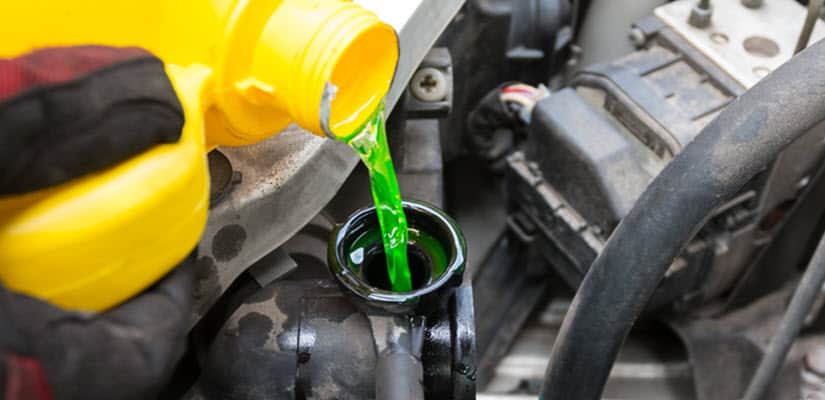Last Updated on September 12, 2023 by Pittalks
Do you think coolant loss is normal ?
If Yes, how much is normal? If No, how much is abnormal?
Based on my experience, losing Zero to a few ounces of coolant every year due to frozen temperature or evaporation is normal. But, if your car coolant loss is more than this, you should consider any problem.
Whether you are a driver or a home mechanic, you must understand that it’s unsafe to drive with a low engine coolant. If you ignore this, it may damage your car engine. So, below are the exact causes of coolant loss to help you know which situation is normal and abnormal.
How Much Coolant Loss Is Normal and Causes?
It’s normal if there is a 0.25% of coolant drop every five months. Losing zero to a few ounces per year is expected. So, after calculation, if your car loses 1-inch coolant every year, there is no need to panic. In my case, I had 06 325i with 60,000 MLS that loses 1.5 inches of coolant per year. The car runs strong, and there is no seepage of coolant on the floor.
On the other hand, my other car, 04 WRX, has a cup or two of coolant loss over 28K miles. Actually, it has an open cooling system, and there is a gap around the return hose from the radiator. And, under high engine temperature, this gap allows for loss of 1 or 2 cups of coolant over 28K miles due to simple evaporation. Now, you know how much your coolant loss is normal. I will tell you why:
Open cooling system
If your car has an open cooling system, no need to worry so much. An open system vents all the time, so evaporation is reasonable. Your car company may ask you to check your cooling system to add coolant four times a year.
Closed cooling system
Someone may think the coolant loss in a closed system is unreasonable because it’s sealed. However; a slight loss in my car when the temperature is frozen. You will see it comes back when it’s warmer.
Another cause is the radiator cap may not be tight, so when under pressure, it may not hold pressure, and evaporation may occur.
So now, you know why there is coolant loss and how much is normal.
Besides, losing how much coolant is problematic and causes?
How Much Coolant Loss Is Abnormal and Causes?
Above, we know how much coolant can be lost and still be normal, so something is wrong if there is more than that.
My jeep had lost more than a cup every 6 months without a leak found. I have already filled the reservoir. I have to fill it again within a year as the coolant is below the MIN line in 56K miles. Initially, I thought it to be normal as there was no leakage. Later, I found that the problem comes from the Blown head gasket. My son’s car has a slow leak that we cannot recognize because his situation is similar to mine.
Below, I will summarize some causes of coolant loss that you need to check right away.
Blown head gasket:
As I see, a blown-up head gasket causes severe damage. Due to this, the coolant level drops alarmingly. As the head gasket blows up, coolant burns off in the combustion chamber, causing damage to the engine.
A Leak:
A coolant leak in the radiator is a common way to lose coolant. Due to fluctuations in engine temperature and low-quality coolant damages the radiator walls. I do not suggest you put water instead of coolant as it corrodes the wall, resulting in rust. As a result, these cause holes in the radiator wall leading to a coolant leak down the line.
Radiator Cap:
The radiator cap maintains the coolant level and pressure in the system. But, if it gets damaged, coolant will try to escape, and reservoir pressure reduces. It eventually causes an abnormal loss in the coolant level. I suggest regular checking of the radiator cap and getting it repaired if there is any damage or rust.
Radiator hose:
Radiator hoses suffer high temperatures, so it’s usual to get damage. If there is any damage or crack, there is continuous spillage of coolant through the damaged radiator hoses. However, there will be abnormal loss in coolant leading to engine damage.
A cracked engine or cylinder head:
It is possible that due to high temperatures and pressure, the engine or cylinder cracks up. This crack leads to coolant leakage causing damage to the functioning of the machine. This is commonly seen in the engine block where the engine block has become compromised due to internal damage that breaks free from the engine casing.
Watch this video for more details:
Final Thought
To summarize how much coolant lost is normal and abnormal, I conclude that losing zero to a few ounces per year is normal. But, if you notice coolant loss of more than a cup every six months then, consider it abnormal. An ideal coolant is non-toxic, avoids corrosion, and has a high thermal capacity. It’s essential to buy suitable coolants and keep an eye on coolant levels to avoid any damage.
Still, have any query in your mind? Comment below your questions and let me know how I can assist you with them.
Related content: Is Coolant Flammable?
FAQs
Let us look over some common FAQs related to how much coolant lost is normal.
Why doesn’t my engine coolant keep appearing?
Your coolant might be leaking over time, allowing it not to appear the same as before. In my opinion, various reasons like evaporation, radiator leakage, cracked engine or hoes may cause your coolant to decrease and not to appear. There may be a problem if the car suffers a considerable loss. So, it’s essential to know how much coolant loss is normal.
Why is my coolant going low so fast?
The lowering of your coolant at a fast pace may indicate that there is a problem in the system. I suggest checking the leakage and get it repaired as soon as possible. There may be chances that there is damage in the radiator causing heavy leakage. Or a blown head gasket is burning your coolant. Moreover, you must know how much coolant lost is normal and get to the dealer if it exceeds.
Why is my car losing coolant but not overheating?
If you are losing coolant without overheating, your car might have leaking antifreeze. I suggest you check if there is any radiator leak, internal coolant leak, or external coolant leak. You must know how much coolant lost is normal to save from any damage.
What happens if my coolant reservoir is empty?
If you have an empty reservoir, there may be chances of overheating the engine. If you do not take precautions, the pressure increases, cracking up the engine or damaging it. I suggest not driving in this case under any circumstances. In my opinion, to save from heavy loss, your reservoir should have a minimum of 30% full. It will help if you know how much coolant lost is normal for your car.
Should the coolant reservoir always be full?
Your coolant level should be between F and L marks on the side of the reservoir. You must know how much coolant lost is normal and fill if required. I would suggest you bring the coolant level to F, but not more than that. By doing so, you have extra space for coolant to expand and contract. Thus, it prevents engine and hose damage.

